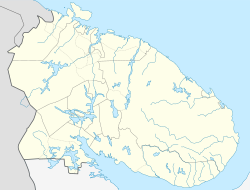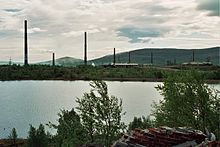Montchegorsk
| city
Monchegorsk
Мончегорск
|
||||||||||||||||||||||||||||||||||||||||
|
||||||||||||||||||||||||||||||||||||||||
|
||||||||||||||||||||||||||||||||||||||||
| List of cities in Russia | ||||||||||||||||||||||||||||||||||||||||
Montschegorsk ( Russian Мончегорск ) is a city in northwestern Russia . It belongs to the Murmansk Oblast and has 45,361 inhabitants (as of October 14, 2010).
geography
The city is located on the Kola peninsula about 140 km south of the Oblast capital Murmansk on the Bay of Montscheguba at the northwest end of Lake Imandra . Immediately west of the city extends up to the 965 meter high mountain range Montschetundra which Bay City and situated northwest smaller lake Montscheosero gave the name ( montsche Sami for beautiful ).
Montschegorsk is administratively directly subordinate to the oblast. The urban area also includes a large, sparsely populated area in the central part of the Kola Peninsula.
The M18 “Kola” St. Petersburg – Murmansk – Severomorsk road runs through the city . The Murman Railway runs on the opposite, eastern bank of Lake Imandra , with which the city is connected via a branch line to Olenegorsk ( Olenja station , goods traffic only).
history
Montschegorsk arose from 1935 in place of the small settlement of Montscha-Guba in connection with the start of the development of a copper and nickel ore deposit discovered in 1934 . Already on September 20, 1937, the place received city rights.
In the city there was the prisoner of war camp 448 for German prisoners of war of the Second World War .
Population development
| year | Residents |
|---|---|
| 1939 | 28,450 |
| 1959 | 45,523 |
| 1970 | 45,980 |
| 1979 | 51,401 |
| 1989 | 68,652 |
| 2002 | 52,242 |
| 2010 | 45,361 |
Note: census data
Culture and sights
Montschegorsk has a local museum and a gem museum.
Although the city itself and its immediate area has by base metals production considerable ecological problems, extends in a westerly direction, the nearly 280,000-hectare nature reserve Laplandski sapowednik ( Lappish Sapowednik ) with management in Monchegorsk. It was set up in 1930 and received the status of a biosphere reserve in 1985 .
economy
The nickel and copper smelter, which today belongs to the MMC Norilsk Nickel concern, is characteristic of the city. Since the local ore deposit has been depleted faster than expected, a large part of the raw materials for production is now being transported from Norilsk in northern Siberia.
Personalities
- Viktor Subkow (* 1941), politician; began his professional career as a locksmith in Montschegorsk
- Valery Zyganow (* 1956), ski racer
- Natalja Golz (* 1985), wrestler, five-time European champion
- Mikhail Ryazanov (* 1986), ice hockey player
- Sergei Ridsik (* 1992), freestyle skier
- Pavel Trichitschew (* 1992), ski racer
- Alexandra Prokopjewa (* 1994), ski racer
Individual evidence
- ↑ a b Itogi Vserossijskoj perepisi naselenija 2010 goda. Tom 1. Čislennostʹ i razmeščenie naselenija (Results of the All-Russian Census 2010. Volume 1. Number and distribution of the population). Tables 5 , pp. 12-209; 11 , pp. 312–979 (download from the website of the Federal Service for State Statistics of the Russian Federation)
- ↑ Maschke, Erich (ed.): On the history of the German prisoners of war of the Second World War. Verlag Ernst and Werner Gieseking, Bielefeld 1962–1977.
Web links
- Montchegorsk on the Oblast Administration website (Russian)
- Private website about the city (Russian)
- Website of the Lapland Sapovednik (Russian)




